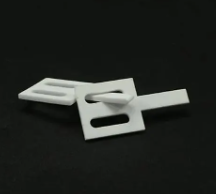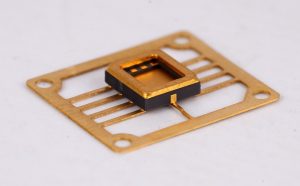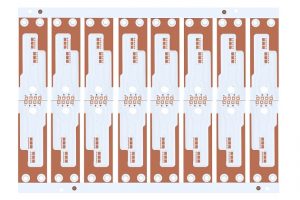Resistors are a key part of any circuit board design. They help regulate current, manage voltage, and protect other components. One type that often appears in various projects is the 3.3 k ohm resistor. Whether you’re building a simple circuit or tackling a complex project, understanding the value and role of a 3.3 k ohm resistor can save you time and effort.
In this article, we’ll dive into what a 3.3 k ohm resistor is, how to identify it using the color code, and the differences between the 4-band, 5-band, and 6-band codes. Additionally, we’ll explain how to read an SMD resistor code, and explore the advantages of using this particular resistor in your projects.
What is a 3.3 k Ohm Resistor?
A 3.3 k ohm resistor is a fixed resistor that has a resistance value of 3,300 ohms. In electronic circuits, resistors limit current flow, divide voltages, and protect sensitive components from damage. The ‘k’ in the resistor’s name stands for kilo, meaning 1,000. Therefore, a 3.3 k ohm resistor has a resistance of 3,300 ohms. These resistors are widely used in both analog and digital circuits, making them a versatile choice for electronics enthusiasts.
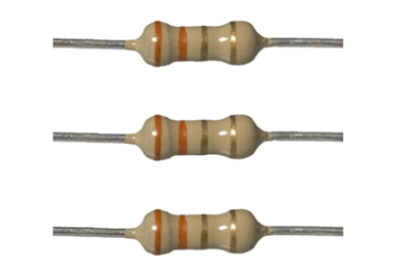
3.3 k Ohm Resistor Color Code
The color code of a 3.3 k ohm resistor is a standardized way to easily identify the resistor’s value. You may notice a series of colored bands on the resistor’s body. Each of these bands represents a number, and when combined, they give you the resistance value.
For a 3.3 k ohm resistor, the color bands would typically be:
- Orange (3)
- Orange (3)
- Red (×100 multiplier)
- Gold or Silver (tolerance)
3.3 k Ohm Resistor Color Bands
Resistors typically have between 4 and 6 color bands. These bands convey different pieces of information such as resistance value, tolerance, and sometimes even temperature coefficient. The bands are read from left to right. Let’s break down a 4-band 3.3 k ohm resistor:
- First Band: The first band indicates the first digit of the resistor value. In this case, orange represents the number 3.
- Second Band: The second band represents the second digit, which is again 3.
- Third Band: The third band is the multiplier, which in this case is red, meaning ×100.
- Fourth Band: The fourth band is either gold (±5%) or silver (±10%) to represent tolerance.
How To Read the 3.3k Ohm Resistor Color Code?
Reading the 3.3k ohm resistor color code is straightforward once you understand how the color bands correspond to numerical values. Here is a resistor color band chart:
| Color | Value | Multiplier | Tolerance |
| Black | 0 | ×1 | N/A |
| Brown | 1 | ×10 | ±1% |
| Red | 2 | ×100 | ±2% |
| Orange | 3 | ×1,000 | N/A |
| Yellow | 4 | ×10,000 | N/A |
| Green | 5 | ×100,000 | ±0.5% |
| Blue | 6 | ×1,000,000 | ±0.25% |
| Violet | 7 | ×10,000,000 | ±0.1% |
| Gray | 8 | ×100,000,000 | ±0.05% |
| White | 9 | ×1,000,000,000 | N/A |
| Gold | N/A | ×0.1 | ±5% |
| Silver | N/A | ×0.01 | ±10% |
| None | N/A | N/A | ±20% |
Step 1: Identify the number of bands
Resistors typically come with 4, 5, or 6 color bands. So, the first thing is to count how many color bands are on the resistor. For a 3.3k ohm resistor, the color bands are used to indicate the value of the resistance and the tolerance.
- 4-Band Resistor: Two significant digits, a multiplier, and a tolerance band.
- 5-Band Resistor: Three significant digits, a multiplier, and a tolerance band.
- 6-Band Resistor: Three significant digits, a multiplier, a tolerance band, and a temperature coefficient band.
Step 2: Read the digits according to the color band chart
For resistors with 4, 5, or 6 bands, the first two or three bands represent the significant digits of the resistance value. For a 3.3k ohm resistor, these digits are “3” and “3,” corresponding to the color orange.
For 5- and 6-Band Resistors, the first three color bands represent the significant digits. So, in a 5- or 6-band resistor, you would still have orange (3) and orange (3), with an additional third digit, typically black (0), in this case.
Step 3: Apply the Multiplier
The next band is the multiplier, which tells you what to multiply the significant digits by. For a 3.3k ohm resistor, the multiplier is red, indicating ×100.
For 4-Band Resistor, the third band is the multiplier. For 3.3k ohms, the third band is red, so you multiply the significant digits (33) by 100, giving you 3,300 ohms. And 5- and 6-Band Resistors, the fourth band is the multiplier. In this case, the multiplier is brown (×10), so the calculation would still result in 3,300 ohms.
Step 4: Check the tolerance
The final band in 4- and 5-band resistors represents the tolerance, which indicates how much the actual resistance value can vary from the stated value. For a 3.3k ohm resistor, this band could be either gold (±5%) or silver (±10%).
- Gold Band: Indicates that the actual resistance can vary by ±5%.
- Silver Band: Indicates that the actual resistance can vary by ±10%.
For example, if the tolerance is ±5%, the actual resistance of a 3.3k ohm resistor could be anywhere between 3,135 ohms and 3,465 ohms.
Step 5: Read the temperature coefficient (if present)
For 6-band resistors, the sixth band represents the temperature coefficient. This tells you how much the resistance changes with temperature, usually measured in parts per million per degree Celsius (ppm/°C). This is particularly important in high-precision circuits where temperature changes could significantly affect the performance of the resistor.
4-Band vs. 5-Band vs. 6-Band 3.3k Ohm Resistor Color Code
The number of bands on a resistor depends on its precision and tolerance. Here’s how the 3.3 k ohm resistor color code varies across different band systems:
| Number of Bands | 1st Band | 2nd Band | 3rd Band | Multiplier | Tolerance | Temperature Coefficient |
| 4-Band | Orange (3) | Orange (3) | Red (×100) | Red (×100) | Gold (±5%) | N/A |
| 5-Band | Orange (3) | Orange (3) | Black (0) | Brown (×10) | Gold (±5%) | N/A |
| 6-Band | Orange (3) | Orange (3) | Black (0) | Brown (×10) | Gold (±5%) | Brown (100 ppm/°C) |
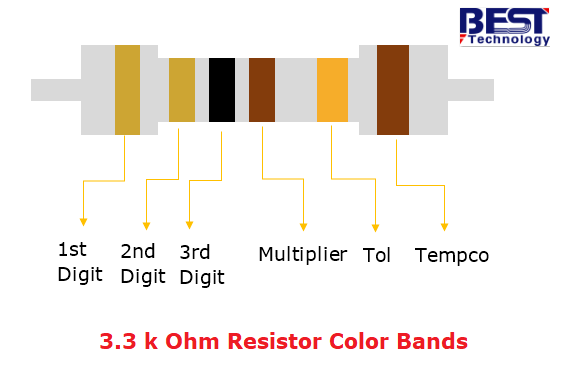
What is the Code for a 3.3 k SMD Resistor?
SMD (Surface Mount Device) resistors are small and lack the space for color bands. Instead, they use numbers to indicate their value. For a 3.3 k ohm SMD resistor, you will often see the code “332.” This code translates to 33 × 100, giving you 3,300 ohms.
What is the Color Code of a 333 k Resistor?
A 333 k ohm resistor has a resistance value of 333,000 ohms. The color code for this resistor would be:
- Orange (3)
- Orange (3)
- Orange (×1,000 multiplier)
- Gold or Silver (tolerance)
Advantages of a 3.3k Ohm Resistor
A 3.3k ohm resistor is commonly used in circuits requiring precise voltage regulation. Its resistance value is particularly suited for voltage dividers, where the ratio of the resistor values determines the output voltage. Here are some advantages of using 3.3k ohm resistor:
1. Precision in Voltage Regulation
2. Ideal for Current Limiting in LED Circuits
3. Commonly Used in Analog Signal Processing
4. Flexibility in Design and Configuration
5. Power Efficiency
6. Compatibility with Digital and Analog Devices
7. Stability and Durability
8. Cost-Effectiveness
What is the Tolerance of a 3.3k Ohm Resistor?
Tolerance refers to how much a resistor’s actual resistance value can vary from its labeled value. Common tolerance levels are ±5% (gold band) and ±10% (silver band). For example, a 3.3 k ohm resistor with a 5% tolerance could have a real resistance value between 3,135 ohms and 3,465 ohms.
Is k the Same as Ohm?
No, ‘k’ and ‘ohm’ are not the same. ‘Ohm’ (Ω) is the unit of resistance, while ‘k’ is a prefix meaning 1,000. So, when we say 3.3 k ohms, it means 3,300 ohms.
FAQs
1. How can I quickly identify a 3.3 k ohm resistor?
Look for the orange, orange, red color bands on the resistor body.
2. What is the role of a 3.3 k ohm resistor in a circuit?
It helps manage current, divide voltage, and protect other components from excess current.
3. Can I use a 3.3 k ohm resistor in high-frequency circuits?
Yes, its stable performance makes it suitable for both high and low-frequency circuits.
4. How do I check if a 3.3 k ohm resistor is working?
You can measure the resistance using a multimeter.
5. Why is a 3.3 k ohm resistor often used in audio circuits?
It offers a good balance of resistance, which is ideal for filtering and reducing noise in audio signals.




